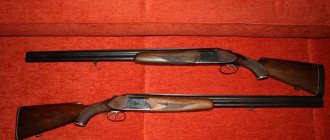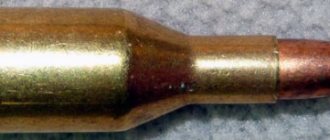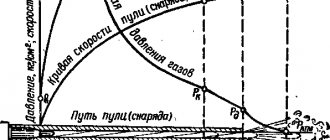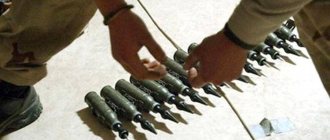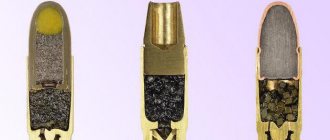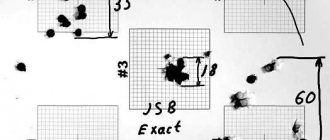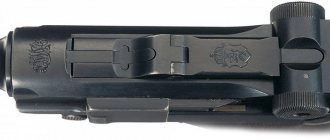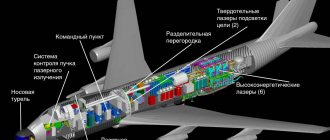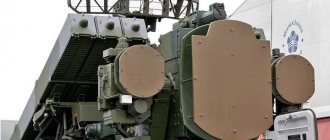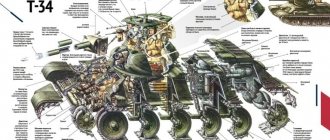Arrow-shaped bullets: a path of false hopes or a story of missed opportunities? Part 2
Among the experimental works of the recent past, one of the most promising and promising was the development of cartridges with feathered sub-caliber bullets for small arms, which were carried out for quite a long time both here and abroad.
But cartridges with FPP (feathered sabot bullets) were never adopted for service either here or abroad. So what was it, why didn’t it take off? This article is devoted to the subject and history of these developments and is largely based on data from the monograph “Combat Cartridges for Small Arms” by Vladislav Nikolaevich Dvoryaninov. The success of any development is ultimately measured only by the results achieved. For small arms – shooting efficiency, the assessment of which is consistently made up of three main factors: 1) hit the target, 2) break through the target’s defense, 3) hit the target. And exactly in the specified sequence. Experts are well aware that taken separately, even such important indicators as dispersion when firing single shots or the penetrating effect of a bullet are NOT direct indicators of effectiveness, but only one of the total set of all factors that influence the final result. To paraphrase the classic, we can say that “issues of efficiency are the most difficult issues in the world”...
Organizing shooting for efficiency is a rather troublesome undertaking, since obtaining reliable results requires professionalism, a large amount of testing and material support, including the availability of well-functioning weapons and an appropriate number of cartridges with stable characteristics. For firing with experimental cartridges in Izhevsk, based on the SVD and PK, the smooth-bore SVDG sniper rifle and the PKG machine gun, shown in the figure, were developed. Interestingly, there were no special requirements for weapons to increase shooting efficiency. On the contrary, experienced smoothbore machine guns and rifles had to match their standard counterparts as closely as possible in order to objectively assess the impact of the new cartridge. For the same reason, the question of a new cartridge case of a “modern shape”, without a protruding rim, was not raised.
At the field tests to evaluate the effectiveness of firing in 1973, the first and simply fantastic results were obtained for sub-caliber weapons: “The experimental machine gun complex, thanks to better flatness of fire, significantly surpassed the standard complex - when firing single shots - by 1.6 and 8.7 times in frequency hitting the target. When firing in bursts from a machine - from 2.47 to 12.6 - 21.3 times in terms of frequency of hitting the target
" Shooting was carried out at a distance of 700, 900 and 1000 meters, at targets No. 8 and No. 11... And this despite the fact that the smooth-bore machine gun at that time was inferior to the standard machine gun in terms of accuracy of combat with experienced cartridges in terms of dispersion area on average by two times. However, only the results of firing single shots were considered sufficiently reliable due to the limited scope of testing when firing in bursts, which is very correct.
During preliminary tests in the fourth quarter of 1980 (at the TsNIITOCHMASH test site, before extended field tests), similar results were obtained. At the same time, the volume of shootings carried out also did not make it possible to call these results completely reliable. But the main, most positive fact was not the multiplicity of superiority, but the actual and significant increase in the frequency of hits. Therefore, the developers, with fairly justified enthusiasm, awaited the results of extended field tests at the Rzhev test site, which were planned for 1981. And the main, main purpose of which was to conduct comparative shooting for efficiency.
But domestic research on machine-gun and rifle cartridges with a feathered sub-caliber bullet was finally stopped in 1983, not least on the basis of the results of these tests. So what happened? Why “suddenly” a promising work that lasted for such a long time and took a lot of effort was closed?
If today we evaluate the main reasons for this decision, it becomes clear that the fate of the project was predetermined even before the tests, based on the sum of several processes within the GRAU, the 4th Main Directorate of the Ministry of Defense and Industry enterprises that took place in those years. Here are the main ones:
Firstly
, the development of cartridges with feathered sub-caliber bullets by Western specialists did not lead to anything, nothing like this was adopted for service and was not planned. And the main reasons for the failures were problems with lethal effect and accuracy. But the main thing is that this time there was no one to catch up with.
Secondly
, it is worth remembering that 1980 - 1983 were the peak, the heyday of the “period of stagnation” in the USSR. The leadership of the Main Directorate and the enterprises of the cartridge industry rejected the degree and volume of innovations that would need to be implemented to master the mass production of new cartridges. The motivation for innovation, as they would say today, was close to absolute zero.
Third
, domestic cartridge makers are to blame themselves... Pyotr Fedorovich Sazonov, a very competent and experienced designer, who for many years was the deputy chief engineer of TsNIITOCHMASH and the head of the entire cartridge direction of the institute, in 1975 proposed a variant of a rifle cartridge with “optimal ballistics in 6-mm caliber”, which according to according to his calculations, it satisfied the requirements for a promising machine gun complex, primarily for the DPV. It is this domestic project that is now commonly called the “six”, or “6x49 rifle”, although the original sleeve length was 54 mm. By 1981, the “six” had gained a sufficient number of supporters in the GRAU, in the Main Directorate and in the leadership of TsNIITOCHMASH, especially taking into account the first two reasons given above. Typical and industry-proven manufacturing technology for all elements of the cartridge, classic design. Yes, it is inferior to the swept ones in all respects, but it must fulfill the long-term requirements. It seems that it turned out to be a quite convenient compromise.
All the authors and ideologists of the radical change in the direction of work on the new machine gun complex were absolutely confident that the “six” could be quickly brought to fruition and put into service. Therefore, the bet was made on this project. And that is why in the conclusion of the Rzhev test site to the 1981 test report it was said: “Given the futility of many years of efforts towards ensuring any acceptable characteristics of the technical dispersion of arrow-shaped bullets, with sufficient damaging effects of the latter, work to study the possibility of creating a rifle cartridge with a arrow-shaped bullet it is advisable to stop." With substantiation in the report itself of another main complaint - the unacceptable danger of flying apart sectors of pallets for friendly troops.
How is this possible, the attentive reader will ask, where did the grouping of those two “sniper” parties (OP 02-81-61 and OP 03-81-61) go? Why did the opinion “suddenly” change about the danger of pallet sectors flying apart and what, strictly speaking? , showed comparative shooting for effectiveness? The answers are surprising and, unfortunately, very simple: They did not consider it necessary to indicate the data of “sniper” shooting in the report and in the final results. Firing for efficiency, which was the main purpose of the tests, was not carried out at all. A detailed “analysis” of the contents of this report, especially taking into account the past 36 years, is no longer of much interest, but some fundamental points require comment.
Experimental cartridges with OPP showed almost the same dispersion as standard cartridges when firing from military weapons, they were supplied to the training ground in the required quantity and nothing prevented comparative firing for effectiveness, even formally.
The damaging and stopping effect of arrow-shaped bullets was higher or equal to standard cartridges with the LPS bullet. And the wording of the conclusion did not correspond to the data of the report itself.
When speaking about the lack of “any acceptable characteristics of the technical dispersion of arrow-shaped bullets,” the range meant the accuracy of firing with single shots compared to the standard 7N1 sniper cartridge. But calculations of the probability of hits when firing cartridges with OPP from a sniper rifle showed that with accuracy similar to standard LPS cartridges, at least equal effectiveness at short distances (up to 300 m) and superiority at longer shooting distances is ensured. And refining an experienced cartridge to the level of accuracy of the 7N1 sniper cartridge additionally increases the probability of a hit by only 9 - 15% due to the dominant influence of a better flat trajectory.
In addition, tests carried out back in the early 60s by firing from machine guns RP-46, SGM and PK with standard cartridges (LPS) in comparison with targeted sports cartridges “Extra” showed that the dispersion area of single shots of sports cartridges was more than 10 times smaller cartridges does not lead to an almost noticeable increase in the efficiency of firing bursts from a machine gun. Which depends, first of all, on the design of the weapon and the amount of recoil energy.
The determination of the actual expansion zone of the pallets during the 1981 tests was carried out “with invention” - 600 shots were fired from a machine gun in long bursts, from a machine, with an elevation angle of 30 degrees. The dispersion zone was determined by the extreme locations of detection of spent pallets on the surface of the earth (freshly fallen snow), without taking into account ricochets. The resulting zone diagram is shown in the following figure on the left. Which in no way coincides with the expansion zone of pallet sectors of the same weight and initial speed, given in the official report of 1973 of the same Rzhev test site and shown in the figure on the right.
The red areas on the diagrams indicate a “dangerous zone due to the impact of pallet sectors on personnel.” The blue sector in the right figure indicates the area in which 70% of all fired pallets were found. In both cases, the same range of the danger zone was obtained - 30 meters from the muzzle, beyond which the sector is safe. At the same time, in 1981, the zone within which the pallet sector was considered “lethal as a fragment” was not defined and allocated. And then, continuing to very intensively lose his speed and energy, his danger decreased from the ability to break through his uniform to the ability to cause a cut or bruise to unprotected areas of the skin. This zone, according to the 1973 report, is shown in the right figure by hatching and is limited to a distance of 14 m from the muzzle. The fundamental difference is the flight angles shown in the diagrams - 56 and 22 degrees, which characterizes the magnitude of the lateral flight of the sectors from the firing line and is the main factor determining the likelihood of a fighter being in the danger zone. There is also data from TsNIITOCHMASH firing in 1978 from the SVDG sniper rifle with the installation of vertical screens at different ranges perpendicular to the direction of fire and measuring the maximum lateral deviation from the firing line of holes from the sectors. Their values are shown in the right figure in red for ranges of 14 and 30 meters. These values are indicative and important because they are more correct compared to the method of finding fired sectors on the surface of the earth, and also because there is no fundamental difference in the spread of sectors when firing from a machine gun and a rifle. Thus, the initial conclusion about the safety of flying sectors for friendly troops should be considered more justified.
Moreover, understanding as well as anyone the undesirability of sectors flying apart when firing from a machine gun and a sniper rifle, choke attachments were developed and tested for crushing plastic pallets. One of the options of which is clearly visible in the photograph of the SVDG given earlier. The result of the “work” of the nozzle is shown in the photo on the left. As comparative shooting showed, such attachments did not affect the accuracy of fire, but their weight, dimensions and survivability were still unsatisfactory, so research in this direction could and should have been continued.
But the decision was made and domestic research on machine-gun and rifle cartridges with a feathered sub-caliber bullet was finally stopped in 1983. How can we evaluate this decision and the results of the work today?
On the one side
, the work really was not ready for the transition to the R&D stage - high-performance equipment and technologies for the manufacture of all elements of the cartridge were not sufficiently developed. It was necessary to refine the technology of casting the plastic sectors of the pallet and stabilize their characteristics. The labor intensity of manufacturing an experimental cartridge with OPP was 1.8 times higher than the labor intensity of manufacturing a standard 7.62 mm rifle cartridge. It was necessary to refine the ordinary and tracer bullets in terms of accuracy of firing with single shots. In other words, it took time, persistence, and ingenuity to complete the work successfully.
On the other side
, to a large extent, all the “natural problems” of the sub-caliber scheme have been solved: the required level of firing accuracy has been practically achieved; an equivalent damaging and greater stopping effect of 4.5 mm arrow-shaped bullets has been achieved; superiority in the penetrating action of high-strength barriers and in the penetrating action of bullets is ensured. The service life of smooth-walled machine-gun barrels exceeded 32 thousand rounds.
The “natural advantages” of the sub-caliber scheme were also confirmed: high ballistic characteristics were achieved, which provided DPV(0.5 m) = 615 m in the dimensions of a standard rifle cartridge, with a 15% lighter cartridge weight and a lower recoil impulse. Superiority in the probability of hitting targets was ensured, increasing as the firing range increased.
But, as already noted, the success of any developments in small arms is ultimately assessed (or rather, should be assessed) only by the result achieved - firing efficiency. Therefore, without these figures obtained with a volume of firing sufficient for reliability, any statement - both about the huge superiority of cartridges with OPP over standard ones, and about the opposite - are not correct. Therefore, in any case, the decision to close the domestic project on cartridges with OPP was premature. Having spent considerable money, time and effort on research, it was necessary, at a minimum, to properly conduct all the necessary tests...
Further development of the “six” was entrusted to the author of works on swept-shaped ones - V.N. Dvoryaninov. In his own words, this work unexpectedly and truly captivated him as a design engineer, arousing professional interest and a desire to understand the reasons for the previous failures of the “six”... A new bullet, cartridge case, primer and powder charge were developed. Unexpectedly for everyone, the new cartridge presented many surprises and problems that had not been encountered before. But almost all of them were solved through original design and technological solutions. The work was brought to the stage of defending the technical design, which, upon completion of the R&D work, is usually followed by the acceptance of the product into service... “Six” was closed in 1991, “simply” not concluding an agreement for the final part of the R&D work. Many believe that this was caused by the collapse of the USSR. Which certainly had an impact. But the main reason was another change in priorities among customers and the promotion of new favorites in military science with the “correct” requirements for cartridges, who in fact were uncompromising adherents of the 7.62 caliber, reasoning by analogy with the well-known rule that “a car can be any color if he's black". But that's a completely different story.
In the domestic history of testing cartridges with OPP, there was another moment, perhaps the most underestimated by customers both then and today. At the initiative of the cartridge makers, simultaneously with the development of the main 10/4.5 mm variant, research was carried out on multi-bullet cartridges. Moreover, returning to the “golden dream” of a single cartridge for an assault rifle and a machine gun, a single-bullet 10/3.5 mm cartridge with a high initial speed (1360 m/s) and a recoil impulse of 0.87 kgf·s was developed. And the second version of the cartridge is a three-bullet one with 2.5 mm arrows. DPV (0.5 m) = 650 and 555 meters, respectively. Firing from a machine gun and a machine gun could be carried out by any of them, with the trajectories pairing, at least within the limits of the DPV. With this solution, an increase in firing efficiency for an assault rifle is achieved not by reducing the recoil impulse and, accordingly, less dispersion during automatic firing from unstable positions, but in all firing positions due to the “volley fire” effect. And, in addition to this, due to a significant increase in DPV and other advantages of sub-caliber bullets with a high initial velocity. It was the absence of such an “addition” in multi-bullet caliber cartridges that did not allow achieving acceptable bullet energies at medium and long ranges, and all attempts to create them in small calibers were considered unsuccessful. In any case, even a “simply multi-bullet” version of a machine-gun-rifle cartridge would be extremely interesting and deserve close attention. The following photograph shows all the main domestic cartridges involved in previous and modern discussions about the ideal cartridge.
The table shows the main technical and ballistic data of these cartridges, according to their order in the photograph. When analyzing and comparing these data, it must be remembered that in practice, not only the total energy of the bullet at the target plays a significant role, but also the specific energy corresponding to the weight and cross-sectional area of each bullet. And when assessing the penetrative effect for classical bullets, it is necessary to consider the specific energy of the core itself. For example, the 10/3.5 mm cartridge does not look as aggressive as a standard rifle cartridge. But recalculation into specific energy gives a different picture. In addition, today the requirement for a machine gun cartridge to penetrate a helmet or anti-fragmentation vest at ranges of up to 1500 meters is very controversial, taking into account the characteristics of typical targets in their area that have changed since the 30s of the last century and, accordingly, the real probability of a hit. For the “six” (third cartridge from the left), the table shows the data achieved by 1981, so that you can objectively assess “what they were choosing from” in that period of time. Third from the right is a mock-up of a three-bullet version of a single cartridge. The following figure shows a graph of changes in the probabilities of bursts hitting target No. 10 “machine gun” when firing from a PKM (from a machine, with a mechanical sight) with a standard 7.62 mm rifle cartridge and 10/2.5 mm three-bullet cartridges (V0 = 1200 m/s) at different target values of the SW x SB dispersion core per 100 m.
The “Limit for 7.62” graph line is an ideal option that takes into account only the dispersion parameters and average aiming errors, and all other shooting errors are taken equal to zero. The lower curve corresponds to the calculated values when taking into account all shooting errors. Calculations for multi-bullet guns were also carried out taking into account all shooting errors. The difference in values between the two curves for a standard cartridge clearly demonstrates the overall impact of errors on the final result. Moreover, the calculations here used data for the “best machine gunners.” The chances of being hit by “medium machine gunners” at ranges over 700-800 meters are, to put it mildly, even more low. As can be seen from the graphs, the superiority of a multi-bullet sub-caliber cartridge in terms of hit probabilities is very significant and allows it to exceed even the maximum possible values for single-bullet cartridges. Against this background, almost all “new” ideas look like children’s games in a sandbox...
A 10/4.5 mm rifle cartridge with a sub-caliber bullet, judging by the available data, should outperform the “six” to a greater extent than the “six” outperforms a standard rifle cartridge. But the costs of rearmament are enormous in both cases. And deciding whether the benefit achieved is sufficient is not easy. For cartridges with sub-caliber feathered bullets, this question still remains open. For the “six,” the more likely answer is “no, not enough,” including taking into account the successful modernization of the standard cartridge carried out in subsequent years.
In conclusion, briefly touching on the discussions about the ways of further development of modern combat cartridges for small arms, we have to largely agree with the opinion of those experts who say that the possibilities for modernizing classical cartridges have been exhausted today. The modernization carried out made it possible to significantly increase the penetration range of high-strength and combined barriers, including modern body armor. But it did not fundamentally affect the probability of hitting targets. It should also be noted that almost any idea that is popular today and considered promising is still built around the classical caliber cartridge design, therefore remaining within the appropriate ballistic framework and restrictions. As a result, it is impossible to achieve a fundamentally new level of efficiency along this path.
Answering the main question of this article, formulated in its title, we can say that the development of domestic cartridges with feathered sub-caliber bullets is, unfortunately, a story of missed opportunities. The sub-caliber scheme, which can combine many modern developments, still remains very attractive for its “natural advantages”. But finally bringing it to fruition in all respects is a rather complex design and technological task. However, it is very likely that there will be no other way to really increase the effectiveness of small arms in the future.
In preparing this article the following materials were used:
“Modern foreign cartridges”, Book-2 of the monograph “Combat cartridges for small arms”. V.N. Dvoryaninov. D'Solo Publishing House, Klimovsk, 2015; “Modern domestic cartridges, chronicles of designers”, Book-4 of the monograph “Combat cartridges for small arms”. V.N. Dvoryaninov. Publishing house D'Solo, Klimovsk, 2015
Not just against armor
In addition to the armor-piercing projectile, a new 30-mm high-explosive fragmentation incendiary ammunition is also being developed.
It should also be lethal to light armored vehicles. This will be achieved thanks to the technology of non-contact detonation of a projectile in flight at a precisely calculated time. The automatic cannon will be able to create a real shower of fragments. This method is especially effective against infantry in trenches and other shelters. It will also come in handy when shooting at small drones. The optimal moment for the explosion of ammunition in the air will be calculated by the standard weapon control system of the combat vehicle. It will also send a detonation command to the optical sensor of the projectile through a special laser.
Bullet_3
25-mm armor-piercing finned sub-caliber projectiles M919
Photo: twitter.com
According to the developer, the advantages of such a scheme are its simplicity and low cost. It does not require complex modernization of the gun itself. Only a laser programmer will need to be installed on the combat vehicle.
According to news agencies, last year the Ministry of Defense ordered a trial batch of such ammunition for testing. They will be tested with guns for armored vehicles and helicopters, as well as with rapid-fire anti-aircraft guns.
Currently in Russia there are three main models of 30 mm guns. They are all designed for the same set of projectiles, which were created back in the 1970s and 1980s. Therefore, the development of new ammunition will increase the capabilities of several lines of equipment with guns of this caliber.
basic information
The key difference between sub-caliber shells and conventional armored shells is that the diameter of the core, that is, the main part, is smaller than the caliber of the gun. At the same time, the second main part - the pallet - is made according to the diameter of the gun. The main purpose of such ammunition is to defeat heavily armored targets. Usually these are heavy tanks and fortified buildings.
It is worth noting that the armor-piercing sabot projectile has increased penetration due to its high initial flight speed. The specific pressure when breaking through armor has also been increased. To do this, it is advisable to use materials that have the highest possible specific gravity as a core. Tungsten and depleted uranium are suitable for these purposes. Stabilization of the projectile's flight is achieved by fins. There is nothing new here, since the principle of flight of an ordinary arrow is used.
story
Steel plates penetrated in tests by naval artillery, 1867
The late 1850s saw the development of the ironclad warship, which carried wrought iron armor of considerable thickness. This armor was virtually immune to both round cast iron cannonballs in use and to the newly developed explosive casing.
The first solution to this problem was carried out by Large Sir W. Palliser, who, with the Palliser shot, invented a method of hardening the head of a pointed cast iron shot. By casting the projectile point downwards and forming the head in the iron mold, the hot metal suddenly cooled and became very hard
(resistant to deformation through martensitic phase transformation), while the rest of the press - molds, are formed from sand, allowed the metal to cool slowly and the body of the shot to be
rigid
(resistant to crumbling).
These cooled iron shots proved very effective against wrought iron armor, but were not effective against compound and steel armor, which was first introduced in 1880. A new offset, therefore, had to be made, and forged steel rounds with water-hardened points take the place of the Palliser shot. At first, these forged steel rounds were made from ordinary carbon steel, but as armor quality improved, the projectiles followed suit.
During the 1890s and thereafter, steel armor became common, initially only on thicker armored ships. To combat this, the projectile was made from forged or cast steel containing both nickel and chromium. Another change was the introduction of a soft metal cover over the point of the shell - the so-called "Makarov Soviets", invented by the Russian admiral Stepan Makarov. This "cap" increased penetration by softening some of the impact of shock and preventing the armor-piercing point from being damaged before it struck the armored face or body shell from breaking. It can also aid penetration at an oblique angle, keeping the point from veering away from the face armor.
An awl instead of a sledgehammer
From the name it is clear that sub-caliber ammunition is a projectile with a caliber noticeably smaller than the caliber of the gun. Structurally, it is a “coil” with a diameter equal to the diameter of the barrel, in the center of which is the same tungsten or uranium “crowbar” that hits the enemy’s armor. When leaving the barrel bore, the coil, which has provided the core with sufficient kinetic energy and accelerated it to the required speed, is divided into parts under the influence of incoming air currents, and a thin and durable feathered pin flies towards the target. In a collision, due to its lower specific resistance, it penetrates armor much more effectively than a thick monolithic blank.
The armor impact of such “scrap” is colossal. Due to its relatively small mass - 3.5-4 kilograms - the core of a sub-caliber projectile accelerates to a significant speed immediately after being fired - about 1500 meters per second. When it hits the armor plate, it punches a small hole. The kinetic energy of the projectile is partially used to destroy the armor, and partially turns into thermal energy. Hot fragments of the core and armor exit into the armored space and spread like a fan, striking the crew and the internal mechanisms of the vehicle. In this case, numerous fires arise.
An accurate hit from the BOPS can disable important components and assemblies, destroy or seriously injure crew members, jam the turret, pierce fuel tanks, undermine the ammunition rack, and destroy the chassis. Structurally, modern sabots are very different. Projectile bodies can be either monolithic or composite - a core or several cores in a shell, as well as longitudinally and transversely multilayered, with various types of tail.
The leading devices (the same “coils”) have different aerodynamics; they are made of steel, light alloys, and also composite materials - for example, carbon composites or aramid composites. Ballistic tips and dampers can be installed in the head parts of the BOPS. In short, for every taste - for any gun, for certain tank battle conditions and a specific target. The main advantages of such ammunition are high armor penetration, high approach speed, low sensitivity to the effects of dynamic protection, low vulnerability to active defense systems that simply do not have time to react to a fast and subtle “arrow”.
Description
Feathered sub-caliber armor-piercing projectile. The process of separating the sectors of the pallet.
Sub-caliber armor-piercing shells are designed to destroy heavily armored objects, in particular tanks. Such a projectile, as a rule, has neither a fuse nor an explosive charge; its armor-piercing effect is entirely due to the kinetic energy of the projectile.
A sub-caliber armor-piercing projectile consists of a coil or other shaped body (pallet), into which a heavy core with a diameter usually about three times smaller than the caliber of the gun is inserted. The material for the core is metal-ceramic hard alloys, which have high strength and hardness. In the middle of the 20th century, this role was predominantly played by tungsten carbide; later, heavy alloy cores made of depleted uranium or tungsten alloys became widespread. The pallet ensures that the core is retained in the barrel, and serves as a kind of piston, taking on the gas pressure when fired, thereby ensuring acceleration of the entire projectile. Due to the smaller mass of the projectile than that of a conventional armor-piercing projectile, the muzzle velocity of the sub-caliber ammunition increases significantly (according to some data, up to 1700 m/s versus 800-1000 m/s), which provides increased armor penetration.
When a projectile hits the armor, a massive core punches a hole of small diameter in it, its kinetic energy is partially spent on destroying the armor, but mostly turns into heat. Fragments of the core and armor heated to high temperatures fly into the armored space in a diverging cone, striking the tank crew, disabling mechanisms and equipment and creating numerous fires. In addition, cores made of depleted uranium, due to their high pyrophoricity, spontaneously ignite upon destruction.
In terms of their action, sub-caliber armor-piercing projectiles have significantly greater armor penetration than caliber armor-piercing projectiles. During Operation Desert Storm, tank units of the US Armed Forces as part of the coalition forces used the M829 armor-piercing projectile - a depleted uranium sub-caliber projectile - to hit targets at distances of up to 3000 m.
Story
The emergence of BOPS was associated with the insufficient armor penetration of conventional armor-piercing and sub-caliber projectiles for rifled artillery in the years after World War II. Attempts to increase the specific load (that is, lengthen their core) in sub-caliber projectiles encountered the phenomenon of loss of rotational stabilization when the projectile length increased beyond 6-8 calibers. The strength of modern materials did not allow the angular velocity of rotation of projectiles to be increased any further.
In 1944, for a 210 mm caliber gun of the K12(E)
German designers created a caliber projectile with a drop-down tail. The length of the projectile was 1500 mm, weight 140 kg. With an initial speed of 1850 m/s, the projectile was supposed to have a flight range of 250 km. A smooth artillery barrel 31 m long was created to fire feathered shells. The shell and gun did not leave the testing stage.
The most famous project using an ultra-long-range finned sub-caliber projectile was that of Chief Engineer Conders. Conders' gun had several names - V-3
, “HDP-High Pressure Pump”, “Centipede”, “Hardworking Lizhen”, “Buddy”. The 150 mm multi-chamber gun used a swept-finned sabot projectile weighing in different versions from 80 kg to 127 kg, with an explosive charge from 5 kg to 25 kg. The caliber of the projectile body ranged from 90 mm to 110 mm. Different versions of the projectiles contained from 4 folding to 6 permanent stabilizer feathers. The elongation of some projectile models reached 36. A shortened modification of the LRK 15F58 cannon fired a 15-cm-Sprgr swept projectile. 4481, designed at Peenemünde, and saw action, firing at Luxembourg, Antwerp and the US 3rd Army. At the end of the war, one gun was captured by the Americans and taken to the United States.
Feathered anti-tank gun shells
In 1944, the 8N63
80 mm caliber, firing a feathered cumulative projectile weighing 3.75 kg with an explosive charge of 2.7 kg. The developed guns and shells were used in combat until the end of World War II.
In the same year, she created the PWK smoothbore anti-tank gun. 10.H.64
caliber 105 mm. The gun fired a feathered cumulative projectile weighing 6.5 kg. The projectile and gun did not leave the testing stage.
Experiments were carried out on the use of high-velocity arrow-shaped sub-caliber projectiles of the Tsp-Geschoss type (from the German Treibspiegelgeschoss - sabot projectile with a pallet) for anti-tank warfare (see below “arrow-shaped projectiles of anti-aircraft guns”). According to unconfirmed reports, German developers at the end of the war experimented with the use of natural uranium in sub-caliber finned projectiles, which ended in vain due to the insufficient strength of unalloyed uranium. However, even then the pyrophoric nature of uranium cores was noted.
Anti-aircraft gun projectiles
Experiments with swept-finned sabot shells for high-altitude anti-aircraft artillery were carried out at a training ground near the Polish city of Blizna under the leadership of designer R. Hermann
). Anti-aircraft guns of 103 mm caliber with a barrel length of up to 50 calibers were tested. During the tests, it turned out that arrow-shaped finned projectiles, which reached very high speeds due to their insignificant mass, had insufficient fragmentation effect due to the impossibility of placing a significant explosive charge in them. [] In addition, they demonstrated extremely low accuracy due to the thin air at high altitudes and, as a result, insufficient aerodynamic stabilization. After it became apparent that swept-finned projectiles were not suitable for anti-aircraft fire, attempts were made to use high-velocity sabot-finned projectiles to combat tanks. Work was stopped due to the fact that serial anti-tank and tank guns at that time had sufficient armor penetration, and the Third Reich was living its last days.
Literature
- Shirokorad A.
God of War of the Third Reich. - M.: AST, 2003. - Karman U.
History of firearms. - M.: Tsentrpoligraf, 2006. - Kozyrev M., Kozyrev V.
Unusual weapons of the Third Reich. - M.: Tsentrpoligraf, 2008. - 399 p. — ISBN 978-5-9524-3370-0; BBK 63.3(0)62 K59.
- Hogg Y.
Ammunition: cartridges, grenades, artillery shells, mortar shells. - M.: Eksmo-Press, 2001. - Irving D.
Weapons of Retribution. - M.: Tsentrpoligraf, 2005. - Dornberger V.
V-2. - M.: Tsentrpoligraf, 2004. - Katorin Yu. F., Volkovsky N. L., Tarnavsky V. V.
Unique and paradoxical military equipment. - St. Petersburg: Polygon, 2003. - 686 p. — (Military History Library). — ISBN 5-59173-238-6, UDC 623.4, BBK 68.8 K 29.
Armor-piercing and feathered
As sources in the defense-industrial complex told Izvestia, new armor-piercing finned sabot projectiles (BOPS) are being created for the Russian Armed Forces. Development work began last summer at the request of the Ministry of Defense. Testing of the new product begins this year. Its design and characteristics are not disclosed.
The ammunition should dramatically increase the effectiveness of high-velocity automatic guns against armored vehicles. The projectile can be used not only on ground combat vehicles. The same guns are installed on the Mi-28 and Ka-52 attack helicopters.
For army aviation, increasing penetration is especially important. Rotorcraft can hit armored vehicles with fire from above, where their protection is weakest. Therefore, even 30-mm BOPS can pose a threat to modern tanks. For lighter equipment they are completely deadly
The ammunition can easily penetrate the walls of strong buildings, which is especially important in urban battles.
Bullet_1
Cartridges for the 30-mm 2A42 cannon of the Mi-28NE helicopter
Photo: RIA Novosti/Vitaly Belousov
In addition to power, sub-caliber projectiles, due to their design features, have high impact speed and accuracy. This makes aiming easier and reduces the flight time to the target. It will no longer be possible to evade the BOPS, and it will be possible to hit the enemy with the first shots.
American Army Bradley-class infantry fighting vehicles, German Marder, Puma, as well as their modern Turkish and South Korean counterparts can withstand, as their manufacturers claim, hits from Soviet 30-mm shells in the frontal projection, Viktor Murakhovsky, editor-in-chief of Arsenal of the Fatherland magazine, told Izvestia .
“In this regard, the emergence of new ammunition is relevant. And the direction for modernization was chosen correctly,” the expert noted. — 30-mm guns continue to be installed on domestic and foreign infantry fighting vehicles and armored personnel carriers. This indicates the demand and prospects, including export, of the new projectile.
30-mm automatic cannons are now the most common in the Russian ground forces, navy and army aviation. The choice of this caliber was made back in the USSR. After careful research, it was found to be the most effective for combating enemy lightly armored vehicles, military historian Alexei Khlopotov told Izvestia.
Bullet_2
MRAP Cougar in service with the US Army in Iraq
Photo: commons.wikimedia.org
“All the main ammunition for guns of this caliber were developed quite a long time ago,” the expert noted. — Considering the trends, the need for new models was discussed back in the late 1980s, but their development was not started for a long time due to the economic problems that followed the collapse of the USSR. Since then, the protection of light military equipment has become much more reliable. Not only new alloys and types of armor appeared, even the appearance of the vehicles changed greatly. MRAPs are powerful armored vehicles for transporting personnel.
Standard ammunition is still coping with its task - destroying infantry fighting vehicles, armored personnel carriers and MRAPs. However, it is necessary to work for the future. BOPS will make it possible to fit them into existing dimensions with a significant increase in armor-piercing, explained Alexey Khlopotov.
In the 1990–2000s, several technically advanced countries developed BOPS for small guns. They are now in service with some NATO member states. An example is the common 25-mm M919 projectile, used in the ammunition of American M2 Bradley infantry fighting vehicles.
There is a known case when in 2003 in Iraq, such an infantry fighting vehicle burned an Abrams tank with “friendly fire” from its rapid-fire cannon. Its small projectiles penetrated the armor of the rear of the vehicle and damaged the engine and ammunition.
Armor-piercing sub-caliber projectile and its description
As we noted above, such ammunition is ideal for shooting at tanks. It is interesting that the sub-caliber does not have the usual fuse and explosive. The principle of operation of the projectile is entirely based on its kinetic energy. If you compare it, it is something similar to a massive high-velocity bullet.
The subcaliber consists of a reel body. A core is inserted into it, which is often 3 times smaller than the caliber of the gun. High-strength metal-ceramic alloys are used as core material. If previously it was tungsten, today depleted uranium is more popular for a number of reasons. During the shot, the entire load is taken by the pallet, thereby ensuring the initial flight speed. Since the weight of such a projectile is less than that of a conventional armor-piercing projectile, by reducing the caliber it was possible to achieve an increase in flight speed. We are talking about significant values. Thus, a finned sabot projectile flies at a speed of 1,600 m/s, while a classic armor-piercing projectile flies at 800-1,000 m/s.

